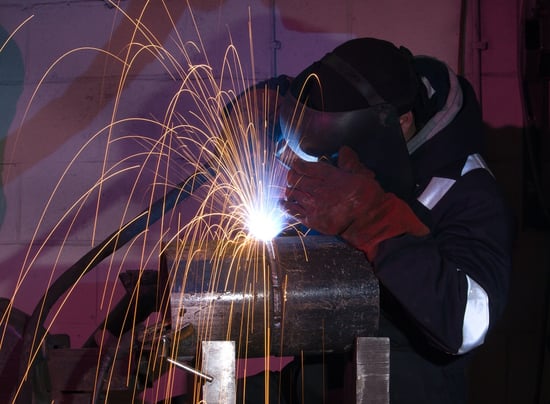Gas-tungsten arc welding (GTAW), or more commonly, Tungsten Inert Gas welding (TIG), is a method of arc welding named for the non-consumable tungsten electrode used during the process. TIG welding isn’t the best option in some industries, but as coil manufacturers, it makes sense for us.
We use it almost exclusively for the level of quality it affords us – TIG welds are very strong and look great when executed properly. For this piece, we’ll focus on why we think TIG welding is the best method for what we do along with some of the tradeoffs that we evaluated before coming to this decision.
Benefits
1. Greater control
One area of TIG welding that helps to increase control is the tungsten electrode used to create the electrical arc. Tungsten’s extreme hardness and high melting point (~3400°C) means that rather than using a consumable electrode that melts into the weld – like stick or MIG welding, – the tungsten electrode heats and melts the filler material that is fed into the weld area by the operator.

The amperage being routed to the electrode is controlled by a foot pedal – which is absent in other welding methods, like MIG welding, in which arc voltage is assigned a preset value, known as constant voltage. This is one of the main areas in which MIG differs from TIG welding, as the amperage in a TIG welding setup is variable.
That method of applying filler material is the second element of TIG welding that helps with control. As we said before, the electrode used in TIG welding is non-consumable, which means the filler metal application step and the heating step are separate, allowing the operator to better control how much filler rod is applied. This differs from MIG welding, where the gun serves as both the electrode and filler material.
2. Versatility
TIG welding is a very versatile method of welding for a few different reasons. First, the tungsten electrode and shielding gas (argon) used in TIG welding can be used for virtually all welding applications, so there’s no need to change it out depending on the job.
TIG welding is also versatile in terms of the materials and alloys it can be used to join. Everything from mild steel all the way up to super-austenitic stainless alloys like AL-6XN® can be welded using a TIG welder. It should be noted that filler rod cost will increase as base metal costs increase. Cheaper rod ($2-3/lb.) is suitable for most carbon steel, but rod can cost $20 per pound or more for filler compatible with alloyed stainless steels like Hastelloy® or AL-6XN®.
TIG welding is also versatile with regard to the positions in which it can be welded. Vertical, overhead, horizontal, and flat welds are all accomplishable using the TIG process and we use all four every day at Super Radiator.
Adding to TIG welding’s versatility is the fact that filler material isn’t always necessary. The high temperatures attainable with the tungsten electrode mean that metals can be fused without adding any material while still maintaining the structural properties of the base metals.
3. Welds don’t need cleaning post-welding
The cleaning benefits of TIG welding compared to other methods is really six of one, half a dozen of another. There are few welding methods that don’t involve a cleaning step, so rather than a benefit, cleaning is more so an area in which TIG welding differs from other methods.
Because TIG welding is so precise and controlled, things like spatter and sparks don’t really come into play, meaning that TIG welds are more or less ready to go once the welding’s been completed. This significantly reduces or eliminates altogether the need for post-weld cleaning steps present in other welding processes, like the MIG welding pictured below.

Drawbacks
With TIG welding, the drawbacks boil down to quality vs. quantity. Most negatives associated with the method center around relative slowness and cost.
1. Lack of speed
There’s no contesting the fact that TIG is a slower process relative to other means of welding. TIG welding is not the method to use if your goal is to crank out product as quickly as possible.
It may seem counterintuitive to use a relatively welding process in a production environment, but because we make a custom product, we feel that the level of quality that TIG welding allows us to achieve offsets speed concerns – it’s not a fast process, but it’s fast enough for what we do.
2. Higher cost associated with TIG
One part of this drawback ties into point #1, as there’s an opportunity cost associated with the longer TIG welding process. Again, it’s a quantity vs. quality thing – speed will never be an advantage of TIG welding.
The other cost associated with TIG welding has to do with the operators themselves. As far as welding goes, TIG is a fairly specialized process, meaning higher operator salaries or training expenses will be incurred.
Another factor to consider with TIG welding is the cost of equipment. Our TIG welders typically cost around $11,000, whereas a similar class of MIG welding machine would cost anywhere between $4,000 and $6,000.
Don’t get left out in the cold when it comes to heat transfer information. To stay up to date on a variety of topics on the subject, subscribe to The Super Blog, our technical blog, Doctor's Orders, and follow us on LinkedIn, Twitter, and YouTube.




